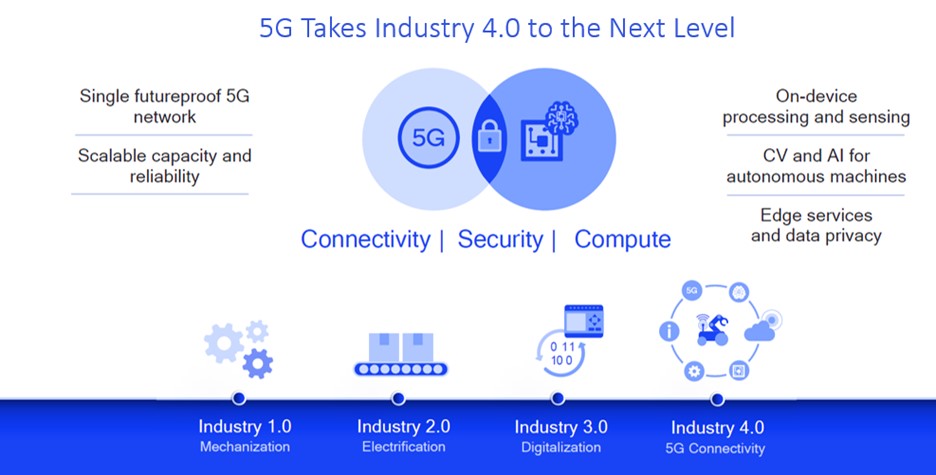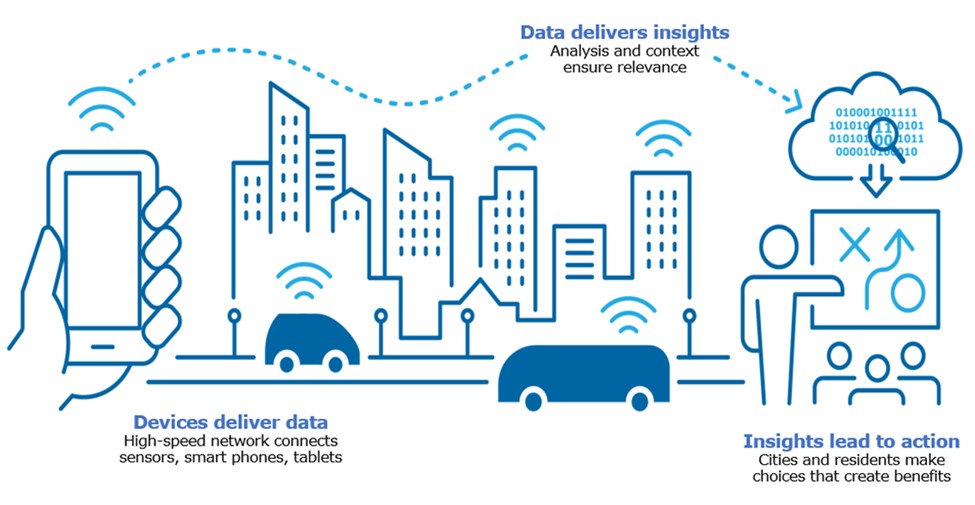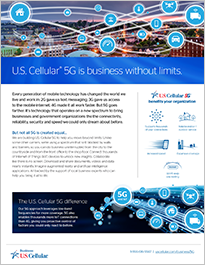The Power of 5G Wireless Technology
By James Rose
The world has seen massive shifts in how we work, operate, buy, sell and communicate. Wireless technology has been key in keeping businesses and communities connected and serving their customers.

Now more than ever, unique and disruptive 5G technologies are improving connectivity, including today’s challenging environments in which governments are operating:
- Networks and solutions must meet the demands of the community
- Industries such as healthcare and education have shifted to remote service, with a massive increase in video traffic
- COVID-19 and other natural disasters create an anxious community that relies on an effective public safety response
The best ways governments can serve communities is by keeping them connected though a secure, reliable network.
Evolving Wireless Networks
Every generation of mobile technology has changed the world we live and work in: 2G gave us text messaging, 3G gave us mobile access to the internet. 4G made it all work faster and saw the explosion of apps and location-based services. 5G goes much further. It is technology that operates on a new spectrum to bring organizations the connectivity, reliability, security and speed we could only dream about before.
5G enhances and augments the data that businesses and governments use. It enables an ecosystem of manufacturers and developers to create new applications. Innovative 5G technology in business models emerges and the way we go about our lives changes.
Many people ask, “What’s going to happen to 4G?” In fact, 5G and 4G LTE™ are meant to coexist. While carriers are investing heavily in deploying 5G, they have at the same time modernized their 4G networks, deploying LTE-advanced technology. This provides a much-improved experience to customers regardless of the technology their device is using.
5G Network Architecture Built for the Internet of Things (IoT)
The Internet of Things (IoT) is expected to see large, exponential growth over the next five years. Low-powered wide-area cellular modules will enable less data consumption and reduced costs for cellular equipment.
These networks are built to support massive IoT deployments. Sensors for various smart city applications such as smart lighting and smart parking become more scalable, and platforms focused on aggregating multiple use cases degrade big data concerns. In addition, automation use cases will drive a spike in operational productivity.
Innovations such as extended-range 5G data calls over millimeter wave (mmWave) and fixed wireless access installations provide a cost-effective way to:
- expand coverage and deliver 5G experiences to communities previously not serviced or lacked a reliable connection
- deliver fiber-like internet speeds wirelessly over mmWave to institutions such as schools, hospitals and town halls
- support high-definition streaming services to improve remote education and remote healthcare
Networks and IoT Working Together

It can be hard to imagine something we haven’t experienced yet — and we haven’t yet seen the full transformation that will come from 5G wireless technology. Industry analysts agree that the next few years will be transformational for 5G business opportunities and communities.
5G networks are deploying technology that delivers 10–100 times faster speeds and allows for hundreds of times as many devices on the network. The latency — the time it takes for a packet of data to be sent and a response to be received — is so low it is not even detectable by humans. That means use cases that require near-instant responsiveness, such as autonomous robots and vehicles, are possible with 5G.
Many government customers have transformed their 5G business potential using wireless IoT technology. For example, law enforcement and first responders rely on dedicated networks and a suite of solutions that ensures they have priority access to their network when they need it most.
In an emergency, public safety professionals are able to communicate no matter how many people may be on the network because they use a dedicated core network with priority access. New 5G capabilities will also allow video and sensor technology to improve the safety of our communities.
Business Continuity
Most businesses don’t have a plan for internet service — one of the most crucial things needed for day-to-day operations. A company with 100 employees can lose up to $151K annually due to ISP outages — the single largest source of downtime cost.
Maintaining a failover internet solution shouldn’t be an overwhelming process. That’s why businesses will benefit from a fully managed connectivity failover solution, from setup support to assistance at a moment’s notice. With a reliable failover internet solution, you can always be ready to do business.
Remote Learning and Working


When sudden changes happen, networks have extra capacity built into the network that acts like a shock absorber, and have redundant assets that can pick up some of the workload when needed. For example, businesses have been adopting cloud solutions at a rapid pace for some time. When a large number of employees is no longer showing up at the office, networks see mobile usage in commercial areas drop while it rises in residential areas.
Artificial intelligence can predict and modify how data moves across the network and shift capacity to where the people are. It can also play a role in security, identifying malware and protecting your business from malicious traffic or hacking attempts.
Globally, approximately 1.7 billion students shifted to remote study after the pandemic.
- Student learning losses vary and are inversely proportional with access to high-quality remote learning
- Almost a third of executives expect needing less office space in the future
- Most expect over half of employees will work remotely at least one day a week
Sources: PwC, June 2020
McKinsey & Company, June 2020
Telemedicine
Connecting to the internet is fundamental to the success of any telehealth solution. That’s why choosing a carrier with a reliable network is key, so that you can be confident patients are able to receive care without leaving home — even if they live in rural areas or don’t have access to the internet.
Advantages of Telemedicine on a 5G network
- Privacy and security
- Password-protected patient records on smartphones and tablets
- Encrypted, secure messaging apps
- Auditable access to patient data
- Employee accountability
- Mobile messaging apps
- Device tracking
- Electronic paperwork
- Operational efficiency
Smart City
The creation of smart cities enables technological advances to help municipalities optimize resources for maximum value to the population, whether that value is financial, time savings or improvement in the quality of life. In a smart city, everything from water pipes to streetlights, cameras, public transport and emergency service assets is connected.

Businesses have deployed a long list of solutions to improve their operational efficiency, and communities are attracted to solutions that can do the same for them and their residents … this is Smart City! Municipalities, utilities and public services all benefit from solutions that leverage the speed, reliability and capacity of 5G.
Advantages include:
- Staying connected and in control, and monitoring and managing your assets with solutions purposely built to work across both urban and rural areas
- Smart parking
- Smart lighting — can result in 50–70% energy savings
- Smart metering for water, gas and electric monitoring — 6–21 gallons of water saved per person per day
- Traffic control
- Smart video — can result in 30–40% fewer crimes
- 100% more residents feel connected to the community
By 2050, Frost & Sullivan expects more than 80% of the population in developed countries to live in cities — many of which will be “smart.”
Private Networks
IoT solutions should allow you — and no one else — to access, monitor and control your remote assets
A private network helps you secure your organization’s data, assets and devices by routing all traffic through a dedicated tunnel that minimizes visibility and vulnerability.
This is done routinely for utilities and any organization deploying industrial IoT, SCADA and solutions for remote monitor and control. There is nearly no capital expense, and the deployment is fast and easy. And you have the assurance of knowing you are working with a mature technology based on global standards.
Private Network Benefits
Confidence
As more and more IoT devices in your business become connected, you can be confident that your private network can minimize your attack surface, reducing your vulnerability.
Security
Whether you are provisioning and deploying a few or a few hundred devices at a time, you can do so quickly and easily on your private network using our cloud-based portal.
Remote Access to Assets
Gain wireless access to remote assets for supervisory control and data acquisition (SCADA) systems or to monitor / control applications without exposing them to potential threats on a public network.
Ease of Deployment
Whether you are provisioning and deploying a few or a few hundred devices at a time, you can do so quickly and easily on your private network using our cloud-based portal.
Whether the impact from 5G is in one or five years, it is coming. Businesses and communities must prepare for the technology today to achieve and manage the impacts that come with this evolution. After all, 20 billion devices were connected in 2020, creating over $300 billion in new revenue. Find out how to use 5G solutions to increase your bottom line. Visit uscellular.com/business or call 866-616-5587.
UScellular 5G is business without limits
Learn more about how UScellular 5G works and what it can do for your organization.






